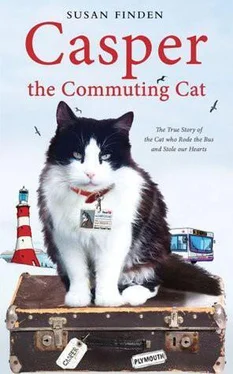He had been discovered onboard a P&O ferry, The Pride of Bilbao , on a Saturday night sailing from Portsmouth to the Spanish port. It was thought that Sandi got into a car that had then driven onto the ferry, then hopped out when it arrived in port. Thankfully, he had been chipped and was returned to his owners, otherwise the poor thing would probably have been put down, as no one would have known where he’d come from or whom he belonged to, and there may have been a fear of rabies. As it was, he was treated like a VIP, with a cabin to himself for the return journey home and meals of chicken and salmon. One report said that most of the staff had been in to give him a cuddle and would be sad to see him go.
Although there are always bad apples in the bunch, Britain is generally a nation of animal lovers, and I find that we do reach out our hearts to cats, dogs and all sorts of other creatures. When we stumble across them by accident, and somewhere we don’t expect to see them – a bus or a chemist’s shop, for example – it’s such a lovely surprise that I believe our good nature takes over and we can’t help but show kindness and affection.
Once Casper’s story started to get so much attention, I became interested in finding out more about other creatures who’d undertaken strange trips. I found more than I could have imagined and I’d love to share a few of them with you.
Throughout history, cats have done the most amazing things. Often their journeys are undertaken not out of curiosity or because they are lost, but to meet more basic needs, such as finding their kittens.
Over a hundred years ago, there was one remarkable creature called Daisy. Although apparently born in Ireland, Daisy was left at a transportation company in Oswego, New York, by some passengers who had left their homeland in 1871. Daisy was regarded as a welcome addition to the buildings, as she was an excellent rat catcher.
Rather like a lot of ladies with careers, Daisy was caught out by nature. One day it was discovered that she had given birth to two kittens, but, for some reason, she had disappeared. This was very strange behaviour, as the babies were barely a week old.
Daisy had been known for her lovely nature and diligence, so it seemed very peculiar that she would go against what her body would be telling her and abandon her little ones. One gentleman who worked for the transportation company, the rather appropriately (or inappropriately) named Mr Pigeon, took the kittens home and tried to raise them Sadly, without their mother’s attention or milk, they died.
Many, many weeks later, one of other workers in the company was crossing a bridge at the depot when he met – as is reported in a journal of the time – ‘the living skeleton’ of Daisy. The same report tells that she was covered in mud, torn and bruised, with her tail almost worn off. She headed straight for the office where she had left her babies all those weeks ago and ‘wauled’ for them. Her poor heart must have broken as she searched high and low for the little mites who had by then passed on. She was comforted by those who worked at the company but she wouldn’t settle.
Some time passed, and a ship came in from Ogdensburg, a place one hundred miles north-east of the depot. The captain saw all the fuss that was being made of Daisy and informed the workers that when he’d last left Oswego, he’d found Daisy was on his ship by mistake. He had put her ashore in Ogdensburg, not knowing what else to do. Apparently, she’d walked all the way back to Oswego, where she’d left her babies, no doubt panicking the whole way over the fate of her little ones. It may have happened well over a hundred years ago, but the power of a mother’s love comes across to this day. I so wish that Daisy’s tale had a happier ending.
More recently, a little male cat called Kuzya, who lived in Siberia, had the most amazing journey. He was only two years old when his family lost him They were living in another part of Russia for the summer holidays and thought the best thing to do was to take Kuzya along, but he ran away in a place called Yakutsk before they returned home to Olenyok. Incredibly, he turned up on their doorstep three months later – thin, exhausted, with bite marks and his claws worn away to almost nothing. Kuzya’s trek home had involved him walking 1,300 miles across Siberia, through woods and hills, crossing rivers and lakes – which rather puts Casper to shame!
Kuzya was by no means the widest travelling moggy, although he did seem to do it all by paw, unlike a kitty called Clyde from Tasmania in Australia. Clyde had been given to a little girl for her birthday, but had wandered off one day. The family got another cat, which unfortunately was run over. They decided they were unlucky and pets weren’t for them – until three years later, when they received a call from a vet in mainland Australia 2,500 miles away. Clyde had been found by a local nurse five months earlier when he’d wandered into a local hospital. She’d taken him home, but when she was moving house, she went to the vet to see if he could be re-homed. The vet discovered he had been chipped and could be returned to his original family. It seems likely that Clyde must have done some of his travelling by car or van, as it was such a long trip – and he made the return trip home by plane.
The capacity of cats to survive is unbelievable. One that was locked in a Cadillac by accident ended up being shipped from the US to Australia. The cat managed to survive for fifty-two days without any food, simply by licking engine grease and eventually eating the car’s instruction manual. I suppose that those were the only options available to the poor little thing.
Other cats have also had no choice but the most awful of options. A few years ago, a woman in California started to feed a group of feral cats near where she worked. They got to know her, and often ran to see what treats she had for them. Over time she started to distinguish one from the other and identify the various characters. She became concerned about one when she realized his whiskers had disappeared – they looked as if they had been burned off. When she investigated further, she noted that there was a big chunk missing from the fur on his rear leg, almost as if it had been bitten off.
The next morning, this young black and white male was in an even worse state. His entire left paw was missing. The lady contacted a pet rescue service and, together, they worked out what was happening. This little soul was gnawing off parts of his body that had been injured. He was slowly dying, even though he was trying to save himself the only way he knew how It was vital that he was captured and helped.
Every day he came to breakfast and managed to evade capture with the help of his mother, who would stand guard as he ate breakfast. The infection would surely kill him He had chewed at his feet so much that the front left leg was gnawed off almost to the shoulder, and the right rear leg to the knee. The fact that he was still eating and still trying to save himself was testament to an incredible survival instinct.
Finally, by following the cat, who was by now being called ‘Stubbs’, and his mum to where they slept, and with the judicious use of some Kentucky fried chicken as bait, they managed to capture him, take him to hospital and treat the injuries. It transpired that someone had set fire to him in a hideous act of cruelty. All four of his feet and lower back legs were terribly burned – so much so that the pain of gnawing them off had been more bearable than leaving them alone. Eventually, even with help, he did lose a back leg up to the knee, a front one to the elbow and a toe from the front, but his amazing will to live, a great deal of medical care and a new home meant that there was a happy ending.
Читать дальше












